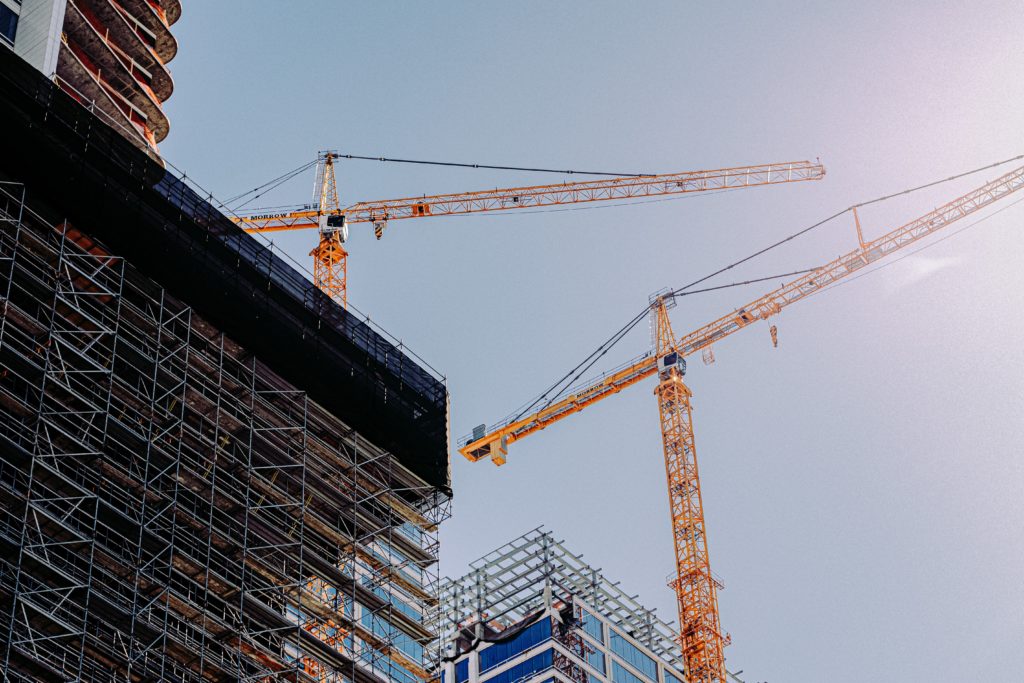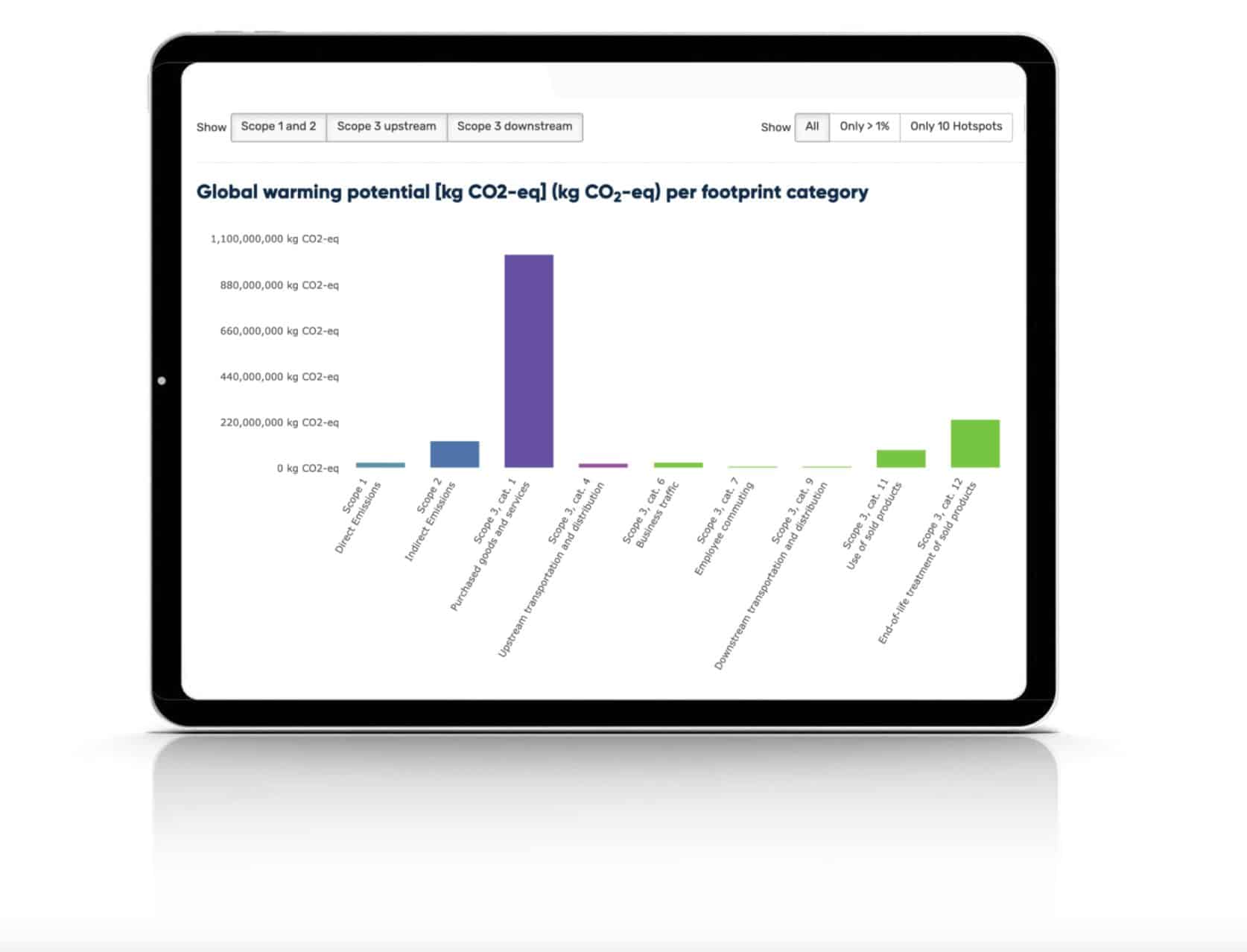Turning environmental data into sustainable action.
You can’t make sustainable improvements in your business, without knowing where you stand in the first place.
A *Life Cycle Assessment (LCA) tells you exactly that. With an LCA, you measure the environmental footprint of a product or your complete product portfolio. The results include impact types such as;
- Carbon footprint,
- Water use,
- Land degradation,
- Impact on biodiversity,
- And 10+ other impact results.
In short: LCA shows you exactly what the impact of your product(s) is- and where it comes from.
How can you use these insights to sustainably improve your business operations?
1. Research and development: Ecodesign
Companies want the impact of their products to be as low as possible. For a number of reasons; corporate policies, regulations, customer demand, or intrinsic company motivations.
Use your environmental footprint results to improve the impact of your product design. This process is called Ecodesign. Find ways to reduce the environmental impact that occurs in every stage of a product’s life cycle- based on your footprint results:
1. The Raw Material Phase: Use less- or better materials (e.g. recycled, recyclable, reusable, sustainable alternative, etc.) in order to reduce the impact of our products.
2. The Processing Phase: Look for ways to reduce waste and material loss during the processing of raw materials. Or aim to redesign your energy- and water usage for your manufacturing processes. Think of greener energy types or energy sourcing, a closed water circuit, or a water purification system.
3. The Transportation Phase: This phase often plays a minor role in the overall impact of a product. But, changes here can still improve your product footprint. Think of using electric vans for distribution or e-bikes instead of cars to deliver your products.
4. The Use Phase: How could you make your customer’s behavior more sustainable by adjusting your products? For example, many consumer electronics require electricity to function- which makes up the biggest chunk of their impact. How can you design your product in such a way, that using it requires less electricity?
5. The Waste Phase: No matter if it’s a fast-moving consumer good (FMCG) or a product with a longer life cycle – at some point, products are disposed of. Try to make reusing and recycling easy for both you and your consumers.
Read our full guide on Ecodesign here.

2. Procurement: Sustainable procurement
Your LCA results will show you exactly which part of your value chain drives the largest environmental impact. Often a big chunk of impact lies in your supply chain or procurement efforts. This makes sustainable procurement a powerful and effective measure for reduction efforts.
Sustainable procurement means that the products and/or services you buy are as sustainable as possible. With the lowest environmental impact and the most positive social results. This will ensure your procurement process is future-proof and long-term.
If you commit to sustainable procurement, we advise you to make sustainable policies on:
(1) How exactly you want to achieve your reduction strategy through procurement;
(2) Possible investments necessary for this process;
(3) To set up fitting sustainability key performance indicators (KPI’s) that align with the requirements of your overall sustainability strategy and important stakeholders.
During this process, have a good look at your company’s core values– and ensure they are reflected in your choices for suppliers and products. Set up selection criteria for both environmental and social performance that request complete transparency and/or environmental claims (such as LCA’s or EPD’s) from suppliers.
You can also try to make your procurement process more sustainable by evaluating your current suppliers. Explore new opportunities in which you can both create shared value in sustainability.
Green Public Procurement (GPP)
Public authorities are often the biggest users of sustainable procurement processes- especially within the construction & infrastructure. That’s because they have a large purchasing power to choose goods and services with reduced environmental impact throughout their life cycle.
With this purchasing power, they can make a significant contribution to sustainable consumption and production. The EU calls this ‘green purchasing’ or ‘Green Public Procurement’.
One of these green procurement selection criteria for large construction and infrastructure projects in the Netherlands and Belgium- is the Environmental Cost Indicator (ECI). Internationally, suppliers deliver Environmental Product Declarations (EPDs) as criteria to win tenders.

3. Commercial: Answering customer demand
You can’t go around it anymore. Globally, 85 percent of people have shifted their purchase behavior towards being more sustainable.
People want sustainable products.
For marketing and sales, measuring your environmental footprint means understanding how sustainable your products are – and how to communicate this to your customers.
A Life Cycle Assessment is the most vital step on that journey. Based on the generated insights, you can see where you already have an edge over your competitors – and where your company can use opportunities to become more sustainable.
LCAs allow marketing and sales to make environmental claims to all relevant stakeholders. And typical reports to do so are Environmental Product Declarations (EPDs) which is a summarized version of an LCA.

4. Operations management: Optimizing Environmental Efficiency
You want to have the highest level of efficiency possible within your organization. Your footprint results can help you do that- sustainably.
The results of an LCA show you where the impact hotspots within your operations lie. It tells you which processes contribute the most to your overall impact. And these processes make the best business case for reduction efforts.
Think of process engineers. Their goal is to create a system within your operations that makes the best use of workers, machines, materials, energy, and information.
Your footprint results show you the exact data on which of your processes lack environmental efficiency the most. This allows process engineers to start looking for better energy sources, redesign production processes, purchase more sustainable machinery, allocate workers, etc.
5. Top-management: Creating a solid sustainability strategy
Embracing circularity & sustainability helps to:
- Attract talent,
- Attract capital,
- Create long-term business value.
Sustainable frontrunners already know it. Having a sustainable company strategy will become the status quo. This requires top management to know exactly what their company’s performance is, regarding the three P’s: people, planet & profit– in order to report and take accountability for them.
An LCA looks at products from a broader point of view than just measuring a carbon footprint (an LCA has 15+ impact outcomes, including GHG emissions). It creates insights that another sustainability analysis might lose out on – an enormous chance for your entire company.
These complete impact results provide top management with credible and actionable insights. It allows you to make strategic decisions based on a solid, measurable foundation. And create a climate & complete sustainability strategy with targets that you can constantly monitor.


